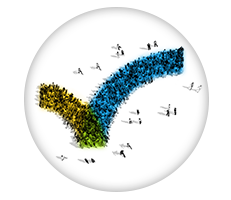How to identify and evaluate B2B buying groups

In B2B today, there is rarely a unilateral buying decision. This means that targeting buyers is a little more complicated. Because your focus shouldn’t be on just one buyer—but a B2B buying group. While individual targeting is not entirely lost, you’ll get farther faster by identifying and marketing to the entire buying group.
What is a buying group?
Just as it sounds, a buying group is a group of individuals who contribute to the purchase decision. A buying group is made up of different roles at an organization, and typically, a decision must be signed off on by everyone in the group before the organization will be ready to buy. According to Forrester, 84% of buyers report they make purchase decisions in groups of three or more when purchasing solutions that cost more than $5,000.
How to identify buying groups
Your solution will likely impact many areas of your buyer’s organization. Each area, be it finance, marketing or IT, will have different concerns and needs to be addressed. The department that uses your solution won’t necessarily be the only one who needs to weigh in.
To identify a buying group, you’ll need to start by identifying which types of job titles will be using your solution, but you also need to think about what other roles at the company may have to sign off on a purchase decision. When you identify those involved, you can more effectively focus your marketing efforts on each of their needs.
Next, you need to align these target personas with actual contacts. Once you know the titles you need to target, use contact data to determine business contacts at your prospect organizations who work in these roles. Work with a data provider to expand your database and fill in any gaps in your first-party data.
Determine buyer roles and map their journey
Individuals in a buying group typically fall into one or more buying role(s), including champion, influencer, decision maker, user and ratifier. Each role serves a unique perspective throughout different parts of the buying journey.
Champions are typically engaged throughout the process and are looking to solve day-to-day challenges or a solution to seize opportunities. Influencers provide expertise but are only involved at certain points in the buyer’s journey—usually at the beginning for research purposes and at the end for solution selection. Decision makers come into the process later to approve the budget during solution selection. Users can be involved throughout the buying process, but their involvement may vary from joining at the beginning of the process to define needs to jumping in later for demos. Ratifiers are the last individuals involved and finalize the decision at the end of the buyer’s process.
Map out your expected buyer’s journey. Use insights from previous customer journeys through the buying process as well as market research to plot it out. Then note which phases each buying role will be involved in. Many roles will be involved at multiple points in the purchase journey. But it’s important to map out where you expect each role to be active so you can reach out to targets and customize messaging and content for when they’re most engaged.
Use intent data for deeper insight
One of the best ways to understand your buying group is by leveraging intent data. Intent data shows you who is researching your solution and provides insight into where these buyers are in the buyer’s journey.
It can give you more information on the buyer’s specific needs and the challenges they are trying to solve. Intent data is particularly valuable for B2B buying groups because you need to target the needs of each persona, not just one member. You can also use it to determine which individual aligns with each persona in your buying group. With their pain points in mind, you can target them with the right message to encourage conversions.
Evaluate for new members
As companies evolve, new roles are created and added to the buying group. You should always keep an ear to the ground and monitor for potential additions to your buying groups. Additions may mean you have to expand your targeting, or it could mean you need to rethink your tactics to cater to a wider set of needs and buying stage levels. For example, if a new member is added to the group who has less general knowledge on the problem you are solving for, you may need to incorporate more top-of-funnel content into your strategy.
As data, security and product have become more and more integral across B2B industries, many companies have added c-level roles to focus on these areas. Roles like chief data officer, chief information security officer and chief product officer may now be a part of your buying group. Monitor for roles like these and consider how they may fit into the buying process—and how you can customize your tactics to market to new buying group roles.
Start Using Buying Groups
Marketing to buying groups is an important strategy for B2B marketers. Understanding the roles of each member of the buying group, how their role is involved in the purchase journey and evaluating for changes and additions to the buying group transforms how you go to market.
Need help getting started? Our Audience Identification and Activation solutions can jumpstart the process by helping you find your buying groups and reach them at the right time.

